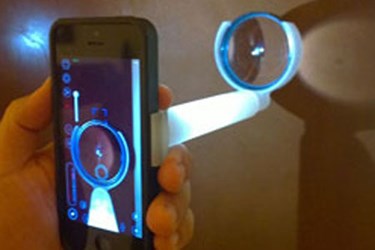Smartphone Adapters Could Enable Tele-Ophthalmology
By Joel Lindsey

A team of researchers at the Stanford University School of Medicine has created two smartphone adapters that allow a phone’s built-in camera to take high-quality photos of the front and back of a person’s eye.
The adapters were developed as more effective and inexpensive alternatives to slit lamps — microscopes with an adjustable, high-intensity light that can be used to create images of the eye.
“I started entertaining the idea of a pocket-sized adapter that makes the phone do most of the heavy lifting,” Robert Chang, assistant professor of ophthalmology and a lead developer on the project, said in a news article published on Stanford’s website.
Chang worked closely with ophthalmology resident David Myung, as well as several other scientists and developers, to create a prototype capable of generating and electronically sharing high-quality images of the eye.
Myung’s group of developers built the prototype devices using readily available, inexpensive parts, many of which he purchased online, according to Stanford’s article. Myung used plastic caps, plastic spacers, LEDs, switches, universal mounts, macrolenses, and an assortment of Legos to create a device capable of imaging the front of the eye while mounted to a smart phone.
In order to create a device capable of imaging the back of the eye, Myung came up with a way to mount a conventional examination lens to a smart phone camera. Designed according to optics theory in order to achieve the correct combination of distance and lighting, the device proved capable of generating high-quality images of the retina.
“It took some time to figure out how to mount the lens and lighting elements to the phone in an efficient yet effective way,” Myung said. “Taking a photo of the retina is harder because you need to focus light through the pupil to reach inside the eye.”
Researchers working on the project claim these devices could significantly alter the way eye medicine is practiced.
“Adapting smartphones for the eye has the potential to enhance the delivery of eye care — in particular, to provide it in places where it’s less accessible,” said Myung. “Whether it’s in the emergency department, where patients often have to wait a long time for a specialist, or during a primary-care physician visit, we hope that we can improve the quality of care for our patients, especially in the developing world where ophthalmologists are few and far between.”
Along with providing an inexpensive, easy to use, and highly portable imaging device, the adapters may also make it easier to electronically share and store important medical data.
The team is currently seeking FDA guidance on moving the devices toward market approval.
“We have gotten the production cost of each type of adapter to under $90 but the goal is to make it even lower in the future,” Chang said. “With smartphone cameras now everywhere, and a small, inexpensive attachment that helps the ancillary health-care staff to take a picture needed for an eye consultation, we should be able to lower the barrier to tele-ophthalmology.”
Smartphone-connected point-of-care devices represent a rapidly growing field of research and development in the industry. Recently, it was reported that scientists had created a solar-powered smartphone device designed to conduct cancer tests in remote areas.
Image Credit: David Myung/ Stanford University School of Medicine
